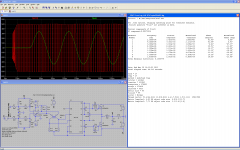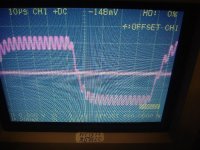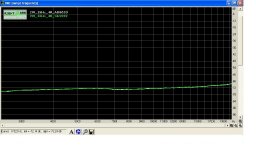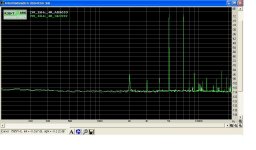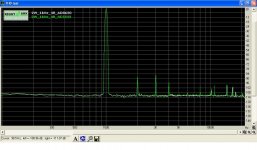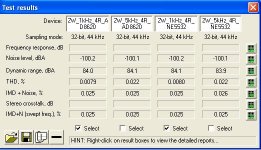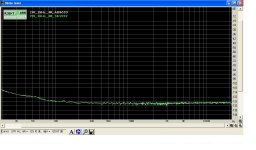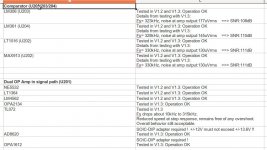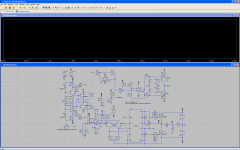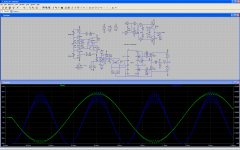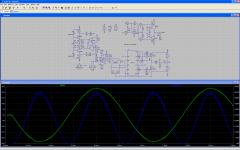SystemD is just my personal cook book for class_D amps, but is not restricted to clocked designs... and I am publishing parts of that here.
Try to find out the meaning of 'Systeme D' in french language and you will understand why I enjoy to call my cook book this way.
SystemD_MD is a clocked type.
SystemD_2k4 is selfoscillating and you should read the beginning of the thread to understand some clues like the dynamic hysteresis, which reduces the frequency drop.
Clipping at 1.2kW unbridged in 2R. 2.4kW bridged into 4R.
The of unbridged operation with a measured THD of 0.09% (posting#276) at 1kW is not indicating sky rocketing distortion at high modulation.

Also the overall more forgiving adjustment of V1.3 with with 0.18% (#317) at 1kW is pretty OK.
Despite good THD figures, IMHO THD is just one of many disciplines.
My personal taste is to adjust my amps for a well balanced trade off all things I can measure and some things I am just believing...
P.S.
The resolution is not directly coupled to Fs. Not at all.
Resolution is limited by the smallest possible change in duty cycle.
Means in analogue PWM generation it is just limited by the noise.
Try to find out the meaning of 'Systeme D' in french language and you will understand why I enjoy to call my cook book this way.
SystemD_MD is a clocked type.
SystemD_2k4 is selfoscillating and you should read the beginning of the thread to understand some clues like the dynamic hysteresis, which reduces the frequency drop.
Clipping at 1.2kW unbridged in 2R. 2.4kW bridged into 4R.
The of unbridged operation with a measured THD of 0.09% (posting#276) at 1kW is not indicating sky rocketing distortion at high modulation.
Also the overall more forgiving adjustment of V1.3 with with 0.18% (#317) at 1kW is pretty OK.
Despite good THD figures, IMHO THD is just one of many disciplines.
My personal taste is to adjust my amps for a well balanced trade off all things I can measure and some things I am just believing...
P.S.
The resolution is not directly coupled to Fs. Not at all.
Resolution is limited by the smallest possible change in duty cycle.
Means in analogue PWM generation it is just limited by the noise.
Thanks Ouro...
Tekko,
you should really read the early pages with the discussion about multiple implementations of a dynamic hysteresis.
In any case... Correct - the effect of dropping frequency is not avoided, but reduced to a more comfortable level.
So far I have no evidence if the frequency drop and increasing ripple of self oscillating amps is audible or not as long as Fs remains far above the audible frequencies.
-From cosmetic point of view it is ugly.
-With respect to switching losses and semiconductor stress the fdrop is highly appreciated.
Tekko,
you should really read the early pages with the discussion about multiple implementations of a dynamic hysteresis.
In any case... Correct - the effect of dropping frequency is not avoided, but reduced to a more comfortable level.
So far I have no evidence if the frequency drop and increasing ripple of self oscillating amps is audible or not as long as Fs remains far above the audible frequencies.
-From cosmetic point of view it is ugly.
-With respect to switching losses and semiconductor stress the fdrop is highly appreciated.
BD modulation solves this as a fullbridge approach virtually quadruples the switching freq, meaning a 250kHz switching freq at the fets still gives the same performance/resolution as a 1MHz single ended class d, unfortunately BD modulation cannot be achieved with a self oscillating topology as the output carrier residual is zero at idle, bringing back the so called disadvantages of clocked class d.
Wrong...!!!
BD just doubles the ripple frequency at the output not quadruples.
A 250khz BD running in full bridge will give you 500khz as carrier ripple at output not 1Mhz.
You are not learning sincerely Tekko.
The BCA in bridge mode does quadruple the switching freq, BD doubles, my mistake.
So please do not write things like "you are not learning" based on a mixup because i was tired and in a slightly bad mood, i was a mouse click away from reporting you for a personal attack before deciding to write this reply!!
I've had a KRAP start of the week at work, so im not really in mood to hear things like "you are not learning"
So please do not write things like "you are not learning" based on a mixup because i was tired and in a slightly bad mood, i was a mouse click away from reporting you for a personal attack before deciding to write this reply!!
I've had a KRAP start of the week at work, so im not really in mood to hear things like "you are not learning"
Measuring an amp is just half of the game. Listening to it is of same importance (or even more?). This design allows tons of variations of OP amps and comparators.
I would have expected that the comparators would play a dominant role for the sound, but to my ears the differences were just very marginal and sort of diffuse – still giving a personal preference on the MAX913.
The OP amps showed a stronger impact and they are changing the sonic character to the amp.
Here my ranking:
1. AD8620:
Very vital and voluminous. Impressive soundstage (despite being mono!) and surprising air. Details unlimited.
2. OPA 1612:
Also vital, but less voluminous. Less soundstage and gradually less air.
3. LT1364:
Vital, but shows no mercy with the shortcomings/harshness of internet radio and some poor MP3.
Pretty OK, when listening to a higher quality source like 192kHz flac.
4. OPA2134:
Very decent. Very comfortable. Not annoying at all. But for my taste sometimes slightly to thin.
5. LM4562:
Slightly pressed. Reducing the ease of music, giving it more a character of hard work.
6. NE5532:
Has similarities to LM4562 ( sorry TI/National guys, please don't shoot me..), but less contours.
In 1980 NE5532 must have been an amazing OP amp.
7. TL072:
Despite the fact that the amp is still working trouble free - the TL072 is the right choice to avoid audiophile satisfaction after spending a lot of efforts and money.
To me it was very surprising to find the character strongly influenced by the OP amps and less by the comparators. Also I would have expected the LM4562 somewhere in the Top3.
Chasing for a correlation between measurements and listening perception, I went for multiple comparative measurements of NE5532 vs AD8620, comparator was always MAX913.
To ensure that my measurements reflect a similar situation like my listening tests, I used the real speakers as load and performed the measurements at a similar level like listening ==> 4Vp.
First picture:
Again the list of alternative components
Second picture:
Spectral noise density
Third picture:
THD at 1kHz and 5kHz
Fourth picture:
Spectrum of 1kHz THD
Fifth picture:
IMD
Sixth picture:
IMD over frequency
Seventh picture:
Step response.
Both measurements in one picture by using the fluorescent storage of the scope. Amazing they equal even in each HF cycle!
By the end of the day I must admit:
Either I am a believer, or my measurements are not covering all relevant properties.
I would have expected that the comparators would play a dominant role for the sound, but to my ears the differences were just very marginal and sort of diffuse – still giving a personal preference on the MAX913.
The OP amps showed a stronger impact and they are changing the sonic character to the amp.
Here my ranking:
1. AD8620:
Very vital and voluminous. Impressive soundstage (despite being mono!) and surprising air. Details unlimited.

2. OPA 1612:
Also vital, but less voluminous. Less soundstage and gradually less air.
3. LT1364:
Vital, but shows no mercy with the shortcomings/harshness of internet radio and some poor MP3.
Pretty OK, when listening to a higher quality source like 192kHz flac.
4. OPA2134:
Very decent. Very comfortable. Not annoying at all. But for my taste sometimes slightly to thin.
5. LM4562:
Slightly pressed. Reducing the ease of music, giving it more a character of hard work.
6. NE5532:
Has similarities to LM4562 ( sorry TI/National guys, please don't shoot me..), but less contours.
In 1980 NE5532 must have been an amazing OP amp.
7. TL072:
Despite the fact that the amp is still working trouble free - the TL072 is the right choice to avoid audiophile satisfaction after spending a lot of efforts and money.
To me it was very surprising to find the character strongly influenced by the OP amps and less by the comparators. Also I would have expected the LM4562 somewhere in the Top3.
Chasing for a correlation between measurements and listening perception, I went for multiple comparative measurements of NE5532 vs AD8620, comparator was always MAX913.
To ensure that my measurements reflect a similar situation like my listening tests, I used the real speakers as load and performed the measurements at a similar level like listening ==> 4Vp.
First picture:
Again the list of alternative components
Second picture:
Spectral noise density
Third picture:
THD at 1kHz and 5kHz
Fourth picture:
Spectrum of 1kHz THD
Fifth picture:
IMD
Sixth picture:
IMD over frequency
Seventh picture:
Step response.
Both measurements in one picture by using the fluorescent storage of the scope. Amazing they equal even in each HF cycle!
By the end of the day I must admit:
Either I am a believer, or my measurements are not covering all relevant properties.
Attachments
Measuring an amp is just half of the game. Listening to it is of same importance (or even more?). This design allows tons of variations of OP amps and comparators.
I would have expected that the comparators would play a dominant role for the sound, but to my ears the differences were just very marginal and sort of diffuse – still giving a personal preference on the MAX913.
The OP amps showed a stronger impact and they are changing the sonic character to the amp.
Here my ranking:
1. AD8620:
Very vital and voluminous. Impressive soundstage (despite being mono!) and surprising air. Details unlimited.
2. OPA 1612:
Also vital, but less voluminous. Less soundstage and gradually less air.
3. LT1364:
Vital, but shows no mercy with the shortcomings/harshness of internet radio and some poor MP3.
Pretty OK, when listening to a higher quality source like 192kHz flac.
4. OPA2134:
Very decent. Very comfortable. Not annoying at all. But for my taste sometimes slightly to thin.
5. LM4562:
Slightly pressed. Reducing the ease of music, giving it more a character of hard work.
6. NE5532:
Has similarities to LM4562 ( sorry TI/National guys, please don't shoot me..), but less contours.
In 1980 NE5532 must have been an amazing OP amp.
7. TL072:
Despite the fact that the amp is still working trouble free - the TL072 is the right choice to avoid audiophile satisfaction after spending a lot of efforts and money.
To me it was very surprising to find the character strongly influenced by the OP amps and less by the comparators. Also I would have expected the LM4562 somewhere in the Top3.
Chasing for a correlation between measurements and listening perception, I went for multiple comparative measurements of NE5532 vs AD8620, comparator was always MAX913.
To ensure that my measurements reflect a similar situation like my listening tests, I used the real speakers as load and performed the measurements at a similar level like listening ==> 4Vp.
First picture:
Again the list of alternative components
Second picture:
Spectral noise density
Third picture:
THD at 1kHz and 5kHz
Fourth picture:
Spectrum of 1kHz THD
Fifth picture:
IMD
Sixth picture:
IMD over frequency
Seventh picture:
Step response.
Both measurements in one picture by using the fluorescent storage of the scope. Amazing they equal even in each HF cycle!
By the end of the day I must admit:
Either I am a believer, or my measurements are not covering all relevant properties.
Im curious if you were blind folder-ed would you be able to make these statements ?
Double blind tests... definitely to much of an effort.
I am not even sure if I could tell the type in a single blind test.
The described sound characters are my perception from listening while I knew about the DUT. Strange enough that even there my perception was different from what my audisoteric opinionated mind told me before....
Sound is like gourmet food.
It tastes better when you can see it and it's looking nice.
There is no clue in killing subconsciously generated feelings, by blind tests.
Still I am doing blind tests once and a while. Unfortunately you always need a second person who is interested in the matter and agrees to spend time for the test.
My last blind test was with cables, because I wanted to prove to myself:You cannot hear it.
I had moved to a new apartment and had positioned the stereo set for an acceptable WAF ==> 12m speaker wires. Ignorant me did this with 2x1mm². The sound was alien, because of the new apartment, but not just alien, also annoying. For some silly reason I thought about the wires and changed the set up to shorter (3m) and multiple paralleled with 2x3x1mm².
Still alien, but less annoying.
In the blind test I had 10 correct out of 13.
From measurements and theory it should have been ignorable...
No it was not the bass which had changed, because of the damping factor.
The bass was unchanged to my ears.
I am not even sure if I could tell the type in a single blind test.
The described sound characters are my perception from listening while I knew about the DUT. Strange enough that even there my perception was different from what my audisoteric opinionated mind told me before....
Sound is like gourmet food.
It tastes better when you can see it and it's looking nice.
There is no clue in killing subconsciously generated feelings, by blind tests.
Still I am doing blind tests once and a while. Unfortunately you always need a second person who is interested in the matter and agrees to spend time for the test.
My last blind test was with cables, because I wanted to prove to myself:You cannot hear it.
I had moved to a new apartment and had positioned the stereo set for an acceptable WAF ==> 12m speaker wires. Ignorant me did this with 2x1mm². The sound was alien, because of the new apartment, but not just alien, also annoying. For some silly reason I thought about the wires and changed the set up to shorter (3m) and multiple paralleled with 2x3x1mm².
Still alien, but less annoying.
In the blind test I had 10 correct out of 13.
From measurements and theory it should have been ignorable...
No it was not the bass which had changed, because of the damping factor.
The bass was unchanged to my ears.
Yup, I think you took it right.This is my interpretation of your Dynamic Hysteresis D-amp circuit.
Your power stage is different, so also your propagation delay (==> fs) and distortion figures may differ from my power stage. But basically it should fit.
WAV files?
You mean you are chasing music through your sim in order to listen to your sim? Playing the output WAV with your normal stereo?
That's a cool idea!!
Well yeah but its a slow process, about 100mS worth of audio takes about 10 hours.
My power stage is a little different as i only have spice models for the IR2110 and the others available at this site: ftp://kavcrl.dyndns.org/+MEDIA/experiments/ExperimentsSoft/LTC/LTspiceIV/lib/sym/yahoogroup/
I might try this out together with the UcD in my other post above and see if i can tell them apart from each other.
My power stage is a little different as i only have spice models for the IR2110 and the others available at this site: ftp://kavcrl.dyndns.org/+MEDIA/experiments/ExperimentsSoft/LTC/LTspiceIV/lib/sym/yahoogroup/
I might try this out together with the UcD in my other post above and see if i can tell them apart from each other.
Last edited:
Hi Tekko,
yes that's the way how it should act.
Nice to see that you use the idea to experiment with your own adjustments to fit voltages, components and personal taste.
I have to admit, I did not investigate in detail which adjustment I really prefer, but just stayed with one reasonable setting so far.
P.S.
I really like the idea to listen to a sim
Edit:
Which switching frequency do you get with your output stage?
yes that's the way how it should act.
Nice to see that you use the idea to experiment with your own adjustments to fit voltages, components and personal taste.
I have to admit, I did not investigate in detail which adjustment I really prefer, but just stayed with one reasonable setting so far.
P.S.
I really like the idea to listen to a sim
Edit:
Which switching frequency do you get with your output stage?
Last edited:
- Home
- Amplifiers
- Class D
- SystemD_2kW, any interest for an open design?
